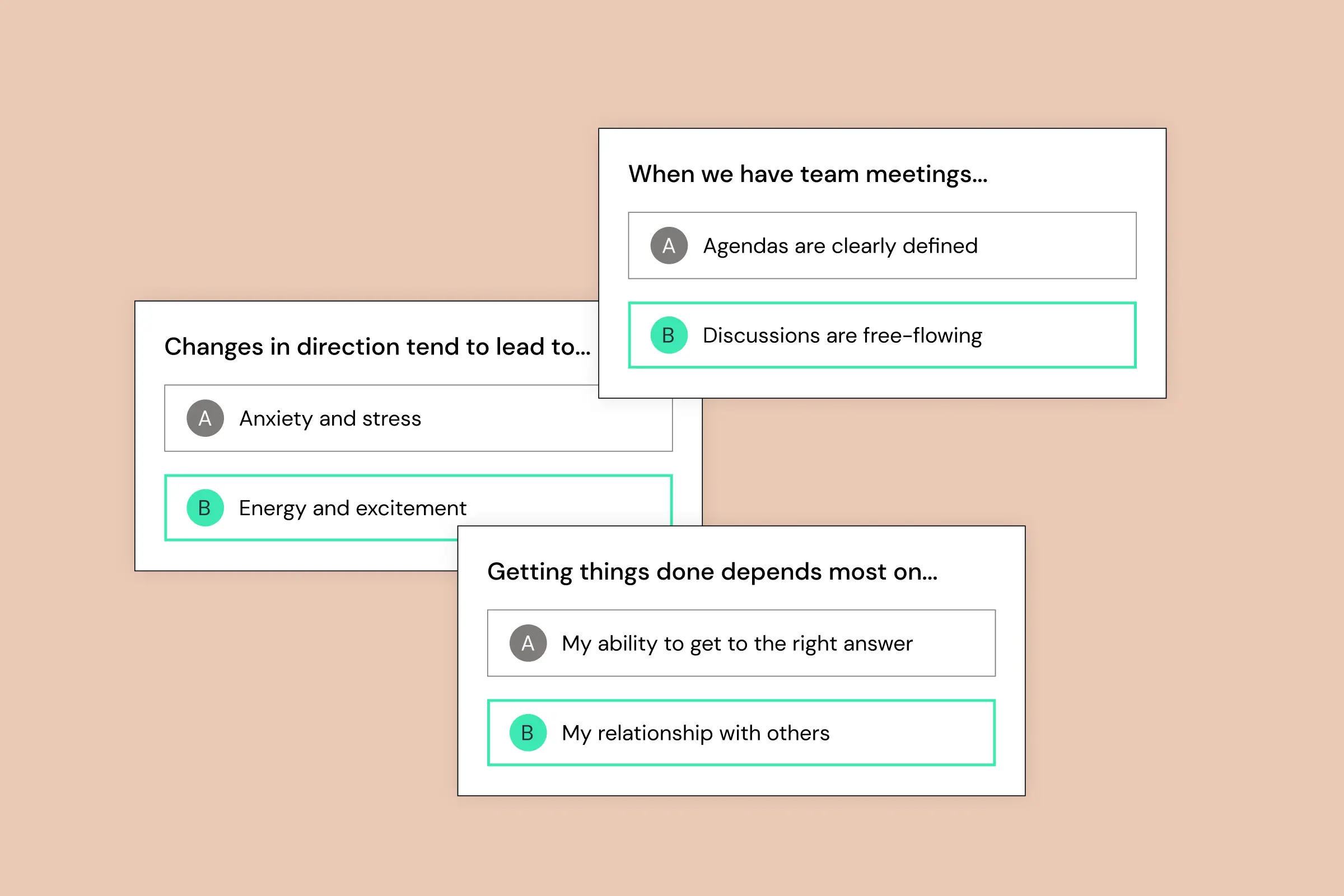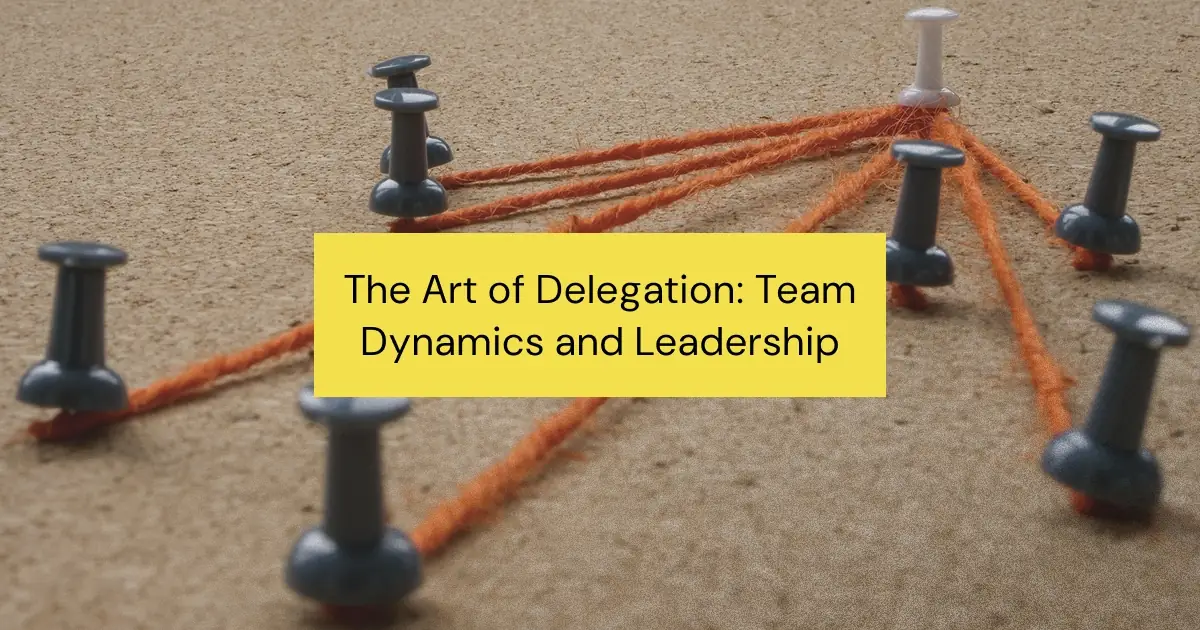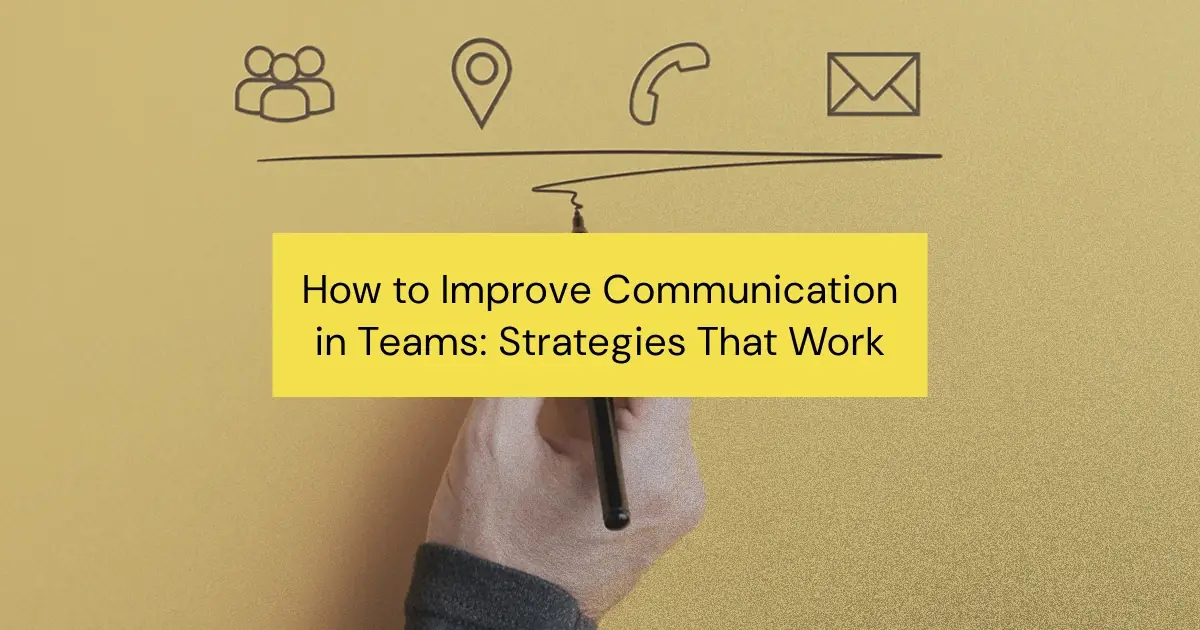In today's fast-paced and diverse work environment, understanding the unique personalities of your team members is crucial for fostering effective collaboration and maximizing team potential. Each individual brings a unique set of strengths, preferences, and communication styles to the table, which can greatly impact the way a team functions. By gaining insights into individual personalities, managers and team leaders can create a supportive and inclusive workplace where everyone can thrive.
Check out our list of the best assessment tools for team building.
Personality tests have emerged as a valuable tool to help teams navigate the complexities of individual differences and unlock their full potential. These assessments can reveal critical information about team members' strengths, working styles, and motivations, enabling teams to capitalize on their collective assets and work more cohesively. In this blog post, we will delve into the importance of understanding individual personalities in the workplace and explore how leveraging personality tests can lead to enhanced team performance and overall success.
Choosing the Right Personality Test for Your Team
A successful team development initiative begins with selecting the most suitable personality test that aligns with your team's goals and objectives. With a plethora of personality assessments available, it's important to understand the unique features of each test and make an informed decision that best fits your team's needs.
Overview of popular personality tests
Before diving into the process of selecting the most suitable personality test for your team, it's essential to familiarize yourself with some of the most popular and widely-used personality tests available. These include:
- Myers-Briggs Type Indicator (MBTI) - A personality assessment based on Carl Jung's theory of psychological types, classifying people into 16 distinct personality types.
- DiSC - A behavior assessment tool that focuses on four primary personality traits: Dominance, Influence, Steadiness, and Conscientiousness.
- TeamDynamics - A comprehensive team assessment tool designed to evaluate and improve group dynamics and overall performance.
- StrengthsFinder - A test designed to help individuals identify their top strengths and talents to maximize their potential.
- Enneagram - A personality assessment that categorizes individuals into one of nine interconnected personality types, emphasizing personal growth and self-awareness.
- Predictive Index - A behavioral assessment tool that focuses on workplace performance, providing insights into individuals' drives, motivations, and work styles.
- Big Five - Also known as the Five-Factor Model, this personality assessment measures five broad dimensions of personality: openness, conscientiousness, extraversion, agreeableness, and neuroticism.
- Hogan Assessments - Measures normal personality, derailers, and core values to predict workplace performance, leadership potential, and team fit.
Criteria for selecting a suitable test for your team
With a variety of personality tests available, selecting the most appropriate one for your team can be challenging. Consider the following criteria to help you make an informed decision:
- Relevance: Choose a test that directly addresses your team's objectives, such as improving communication, identifying strengths, understanding your team's working styles, or enhancing decision-making processes.
- Validity and Reliability: Select a test that has been well-researched and validated, ensuring that the results are consistent and accurate.
- Ease of Administration and Interpretation: Opt for a test that is user-friendly and easy to understand, allowing team members to effectively apply the insights gained.
- Cost and Time Considerations: Be mindful of the financial and time investment required for administering the test and subsequent training or workshops.
- Customization and Flexibility: Choose a test that can be tailored to your team's specific needs and allows for adaptation as the team evolves.
Importance of considering team objectives and desired outcomes
When selecting a personality test, it's crucial to keep your team's objectives and desired outcomes in mind. Doing so ensures that the test you choose will provide the most relevant and actionable insights for your team. For example, if your goal is to improve communication and collaboration within the team, a TeamDynamics assessment may be more suitable. Conversely, if you aim to discover and leverage individual strengths to optimize team performance, the StrengthsFinder assessment may be a better fit.
In conclusion, choosing the right personality test for your team involves a careful evaluation of various factors, including the test's relevance, validity, and ease of administration. By aligning your selection with your team's objectives and desired outcomes, you can ensure that the test will provide valuable insights to enhance team performance and create a more cohesive and productive work environment.
Administering a Personality Test with Your Team
Successfully implementing a personality test within your team requires careful planning and consideration. By following best practices, respecting confidentiality, and addressing concerns or misconceptions, you can create a positive experience for your team members and maximize the benefits of the assessment.
Best practices for conducting the test
- Communicate the purpose: Clearly explain the objectives of the personality test and how it will benefit the team. Emphasize that the goal is to enhance team performance, not to evaluate or judge individual team members.
- Schedule a dedicated time: Set aside an uninterrupted block of time for team members to take the test. This allows them to focus and thoughtfully answer the questions.
- Provide clear instructions: Ensure that team members understand how to complete the test and have access to any necessary resources or support.
- Encourage honest responses: Emphasize the importance of answering the test questions truthfully and without overthinking. Remind team members that there are no right or wrong answers.
{{inline-cta}}
Ensuring confidentiality and trust
- Respect privacy: Assure team members that their individual results will remain confidential unless they choose to share them. Explain that the focus will be on collective insights, not individual evaluations.
- Foster a supportive environment: Encourage team members to be open and non-judgmental when discussing test results, and emphasize the value of diverse perspectives and strengths.
- Use anonymized data: When presenting aggregate results, consider using anonymized data to protect individual privacy and maintain trust within the team.
Addressing any concerns or misconceptions about the test
- Address common misconceptions: Clarify that personality tests are not meant to label or limit individuals, but rather to provide insights into their strengths, preferences, and communication styles.
- Encourage open dialogue: Invite team members to voice any concerns or questions about the test, and address them in a transparent and supportive manner.
- Share limitations: Acknowledge the limitations of personality tests and explain that they are just one tool among many for understanding and improving team dynamics.
- Provide additional resources: Offer resources or articles that can help team members better understand the chosen personality test and its intended applications.
By carefully planning the administration of a personality test and ensuring a supportive and confidential environment, you can maximize the benefits of the assessment for your team. Addressing any concerns or misconceptions about the test will help build trust and create a positive experience for everyone involved, ultimately leading to more effective teamwork and improved performance.
Interpreting and Sharing Personality Test Results in a Team Setting
Effectively interpreting and sharing the results of a personality test within your team is crucial for leveraging the insights gained and promoting a positive work environment. By understanding individual results, facilitating meaningful group discussions, and creating a safe space for open communication, you can foster a more cohesive and high-performing team.
Understanding individual results and their implications
- Encourage self-reflection: Ask team members to review their results and consider how their strengths, preferences, and communication styles impact their work and interactions with others.
- Highlight diversity: Emphasize the value of different personality types and the unique contributions each individual brings to the team.
- Connect results to team objectives: Help team members understand how their personality traits relate to the team's goals and objectives, and identify potential areas for growth and development.
Facilitating group discussions to share results and insights
- Set clear expectations: Before beginning group discussions, establish guidelines for respectful and non-judgmental communication to ensure a positive experience for everyone involved.
- Share collective insights: Present aggregated results to the team, highlighting patterns, strengths, and areas for improvement without singling out individuals.
- Encourage voluntary sharing: Invite team members to share their individual results and insights if they feel comfortable doing so, but avoid pressuring anyone to disclose personal information.
- Foster collaborative learning: Use group discussions as an opportunity for team members to learn from one another and explore ways to leverage their diverse strengths and preferences for the benefit of the team.
Creating a safe space for open and honest communication
- Demonstrate vulnerability: As a team leader, consider sharing your own results and insights first, as this can create a sense of trust and encourage others to open up.
- Practice active listening: Give each team member the opportunity to speak and be heard. Listen attentively, ask open-ended questions, and avoid interrupting or dismissing others' perspectives.
- Encourage empathy and understanding: Foster an environment where team members are encouraged to put themselves in others' shoes and appreciate the diverse perspectives and experiences within the team.
- Address conflicts constructively: If conflicts or disagreements arise during discussions, address them in a respectful and solution-oriented manner. Encourage open communication and work together to find common ground.
By effectively interpreting and sharing personality test results in a team setting, you can create a more inclusive and supportive work environment. By understanding individual results, facilitating meaningful group discussions, and fostering open and honest communication, your team will be better equipped to capitalize on its collective strengths and achieve greater success.
Leveraging Personality Test Insights for Team Success
Once your team has taken a personality test and shared their results, it's essential to translate these insights into actionable strategies that enhance team performance. By identifying team strengths, aligning roles with individual strengths, and fostering a supportive culture, you can unlock your team's full potential.
Identifying team strengths and areas for improvement
- Analyze collective results: Review the aggregated test results to identify patterns, strengths, and areas where your team could improve.
- Address skill gaps: If the results reveal any skill gaps within the team, consider providing training, resources, or support to help team members develop the necessary skills.
- Celebrate strengths: Acknowledge and celebrate the unique strengths and talents each team member brings to the table, reinforcing the value of their contributions.
Aligning team roles and responsibilities with individual strengths
- Optimize role assignments: Review current team roles and responsibilities, and consider adjusting them to better align with individual strengths and preferences.
- Encourage collaboration: Pair team members with complementary strengths and skill sets to work together on projects, fostering collaboration and mutual learning.
- Support professional development: Provide opportunities for team members to further develop their strengths and explore new areas of interest, enhancing their career growth and job satisfaction.
Fostering a supportive and inclusive team culture
- Encourage open communication: Promote a culture where team members feel comfortable sharing their thoughts, ideas, and concerns, and provide regular opportunities for team check-ins and feedback.
- Embrace diversity: Celebrate the different personalities, backgrounds, and perspectives within your team, and emphasize the value of diverse viewpoints in fostering innovation and problem-solving.
- Adapt leadership style: Recognize that different team members may respond better to different leadership styles or approaches. Adapt your leadership style to better support each individual and help them reach their full potential.
- Build trust and psychological safety: Foster an environment where team members feel safe to take risks, make mistakes, and learn from them. Encourage mutual support, empathy, and constructive feedback among team members.
By effectively leveraging personality test insights in your team, you can create a more cohesive and high-performing work environment. Identifying team strengths, aligning roles with individual talents, and fostering a supportive and inclusive culture will empower your team members to excel in their roles and contribute to the team's overall success.
Implementing Strategies for Team Growth Using Personality Test Insights
Personality test insights can serve as a catalyst for creating targeted strategies to facilitate team growth and development. By designing interventions based on these insights, promoting self-awareness and personal growth, and tracking progress, you can ensure your team continues to evolve and thrive.
Developing targeted interventions based on personality insights
- Tailor training programs: Customize team training and development programs to address specific areas of improvement identified through the personality test results.
- Address communication barriers: Develop strategies to improve communication and collaboration among team members with different communication styles and preferences.
- Enhance decision-making processes: Use the insights gained from the test to identify potential biases or blind spots within the team and develop strategies to counteract them, leading to more balanced decision-making.
Encouraging ongoing self-awareness and personal growth
- Promote regular reflection: Encourage team members to periodically review their personality test results and reflect on their personal growth, strengths, and areas for improvement.
- Set individual development goals: Help team members set specific, measurable, and achievable personal development goals based on their test results and support them in their efforts to achieve these goals.
- Foster a learning culture: Create an environment where continuous learning and development are valued, and provide access to resources, training, and mentorship opportunities.
Tracking progress and measuring the impact of changes
- Monitor team dynamics: Regularly observe team interactions and dynamics to identify any positive changes or areas where further improvement is needed.
- Collect feedback: Gather ongoing feedback from team members about their experiences and the impact of the implemented strategies, making adjustments as necessary.
- Measure performance indicators: Track key performance metrics related to team collaboration, productivity, and engagement to evaluate the effectiveness of the implemented strategies.
- Conduct follow-up assessments: Periodically administer follow-up personality tests or other assessments to gauge progress and identify any new areas of focus for team growth and development.
By implementing targeted strategies based on personality test insights, you can foster a culture of continuous growth and improvement within your team. Developing tailored interventions, encouraging self-awareness and personal growth, and tracking progress will help your team members flourish in their roles and contribute to the overall success of the organization.
Addressing Limitations and Potential Pitfalls of Using Personality Tests for Team Performance
While personality tests can provide valuable insights to improve team performance, it's important to be mindful of their limitations and potential pitfalls. By avoiding over-reliance on tests, preventing stereotyping, and recognizing the dynamic nature of personality and team dynamics, you can ensure a balanced approach to team development.
Avoiding over-reliance on personality tests
- Use multiple tools and approaches: Remember that personality tests are just one tool among many for understanding and improving team dynamics. Complement these assessments with other approaches, such as team-building exercises, feedback sessions, and ongoing training.
- Acknowledge limitations: Be transparent about the limitations of personality tests, including the potential for inaccurate or incomplete results, and emphasize the importance of using these insights as a starting point for growth and development.
Preventing stereotyping and pigeonholing of team members
- Emphasize individuality: Encourage team members to view their test results as a snapshot of their preferences and tendencies, rather than fixed labels that define them.
- Focus on strengths: Highlight the unique strengths and contributions of each team member, rather than using test results to categorize or limit their potential.
- Foster a growth mindset: Promote a culture where team members are encouraged to learn, grow, and develop beyond their initial test results, and provide opportunities for continuous development.
Recognizing the dynamic nature of personality and team dynamics
- Account for change: Understand that personality traits and preferences can evolve over time due to personal growth, life experiences, and changes in work environments. Be open to reassessing team members' traits and preferences periodically to account for these changes.
- Adapt to shifting team dynamics: As team members grow and evolve, so will the team's dynamics. Regularly reassess and adjust strategies to address any changes in team composition, roles, or objectives.
- Encourage flexibility: Encourage team members to be open and adaptable to different working styles and perspectives, rather than rigidly adhering to their personality test results.
By being mindful of the limitations and potential pitfalls of using personality tests to improve team performance, you can create a more balanced and effective approach to team development. By avoiding over-reliance on tests, preventing stereotyping, and recognizing the dynamic nature of personality and team dynamics, your team will be better equipped to capitalize on the insights gained and achieve greater success in the workplace.
Complementary Approaches to Enhance Team Performance
While personality tests can provide valuable insights into team dynamics, it's important to complement them with additional approaches to maximize team performance. By combining personality tests with other team development tools, incorporating team-building activities, and promoting continuous learning and development opportunities, you can create a comprehensive strategy for team success.
Combining personality tests with other team development tools
- TeamDynamics: Utilize tools like TeamDynamics, which focuses on assessing and improving team cohesion, communication, and effectiveness, to gain a more holistic understanding of your team's dynamics.
- Belbin Team Roles: Use assessments like Belbin Team Roles to identify the specific roles and contributions of each team member, allowing you to optimize team composition and leverage individual strengths more effectively.
- Customized assessments: Consider developing customized assessments that address your organization's specific needs, values, and objectives, providing tailored insights to drive team performance.
Incorporating team-building activities and exercises
- Offsite retreats: Organize offsite retreats or workshops that provide team members with opportunities to bond, collaborate, and develop their skills in a relaxed and informal setting.
- Problem-solving challenges: Engage your team in problem-solving exercises that require collaboration, creativity, and effective communication, fostering a sense of unity and shared purpose.
- Regular team check-ins: Schedule regular team check-ins or debrief sessions to discuss progress, challenges, and successes, encouraging open communication and continuous improvement.
Promoting continuous learning and development opportunities
- Professional development: Offer access to professional development opportunities, such as training courses, workshops, and conferences, to help team members expand their skills and knowledge.
- Mentoring and coaching: Establish mentoring or coaching programs within your organization to provide team members with personalized guidance and support for their growth and development.
- Knowledge sharing: Encourage team members to share their expertise and learnings with one another, fostering a culture of continuous learning and collaboration.
- Cross-functional projects: Provide opportunities for team members to work on cross-functional projects or assignments, allowing them to gain new perspectives and experiences while collaborating with colleagues from diverse backgrounds and disciplines.
By incorporating these complementary approaches to enhancing team performance alongside personality tests, you can create a well-rounded strategy that addresses various aspects of team dynamics and development. Combining different assessment tools, team-building activities, and continuous learning opportunities will empower your team members to excel in their roles and contribute to the overall success of the organization.
Case Study: Successful Implementation of a Personality Test in the Workplace
Company: smartSHIFT Software, a mid-sized technology company.
Challenge: The company was experiencing challenges with team collaboration, communication, and productivity. Management recognized the need to improve team dynamics and optimize individual strengths to drive better results.
Solution: smartSHIFT Software decided to implement TeamDynamics, a tool designed to assess and improve team cohesion, communication, and effectiveness. The company followed a structured process that included:
- Selecting and administering the TeamDynamics assessment to all team members.
- Ensuring confidentiality and trust throughout the testing process.
- Facilitating group discussions to share results and insights.
- Identifying team strengths and areas for improvement.
- Aligning team roles and responsibilities with individual strengths.
- Fostering a supportive and inclusive team culture.
Results: Following the implementation of the TeamDynamics assessment and subsequent team development initiatives, smartSHIFT Software saw significant improvements in team communication, collaboration, and overall performance. Team members gained a better understanding of each other's work styles and preferences, leading to more effective collaboration and higher job satisfaction.
Key Takeaways and Lessons Learned
- The importance of selecting the right team development tool: smartSHIFT Software carefully evaluated various tools before choosing TeamDynamics, ensuring it was the most suitable assessment to address their specific needs and objectives.
- Creating a safe environment: The company ensured that confidentiality and trust were maintained throughout the testing process, allowing team members to feel comfortable sharing their results and discussing their insights.
- Leveraging insights for actionable strategies: smartSHIFT Software used the TeamDynamics results to develop targeted interventions, such as adjusting team roles and responsibilities, addressing communication barriers, and offering tailored training programs.
- Fostering a culture of continuous growth and development: The company encouraged team members to view their assessment results as a starting point for personal growth, promoting a growth mindset and providing ongoing opportunities for learning and development.
- Monitoring progress and impact: smartSHIFT Software tracked key performance metrics and gathered regular feedback from team members to measure the effectiveness of their strategies and make adjustments as needed.
This case study highlights the potential benefits of implementing a team development tool like TeamDynamics in the workplace when done thoughtfully and strategically. By selecting the right assessment, creating a safe environment, leveraging insights, fostering a culture of growth, and monitoring progress, organizations can significantly improve team performance and drive better results.
Conclusion
In conclusion, using personality tests with your team in the workplace offers numerous benefits for team development, such as increased understanding of individual preferences, work styles, and strengths. These insights can lead to improved communication, collaboration, and job satisfaction among team members, ultimately enhancing overall team performance.
However, it's essential to adopt a well-rounded approach to team performance and growth by combining personality tests with other team development tools, team-building activities, and continuous learning opportunities. This balanced strategy ensures that organizations can address various aspects of team dynamics while avoiding the limitations and potential pitfalls associated with relying solely on personality tests.
As you explore the potential of personality tests in your workplace, remember to choose the most suitable test for your team's needs and objectives, create a safe environment for open communication, and leverage the insights gained to drive targeted interventions and foster a culture of growth and development. By doing so, you can unlock the full potential of your team and create a more cohesive, supportive, and high-performing workplace environment.




.png)











































